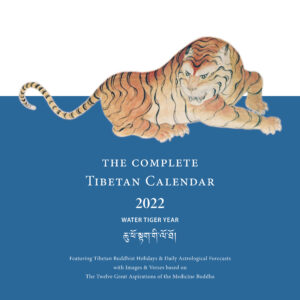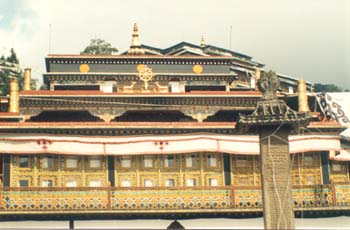Tibetan Calendar Traditions

To help preserve an ancient Tibetan tradition of calculating dates and formulating a yearly calendar, Nitartha international and Nalandabodhi annually publish a Tibetan calendar by Dr. Karma Drubgyud Tendhar. Dr. Tendhar uses the Tsurluk system of calculation, developed in the Karma Kagyu tradition.
The Tsurluk tradition, an alternative to the Phukluk tradition of calculating the calendar, is still in wide use today in Tibet. Primary responsibility for continuing the Tsurluk calendar today rests with Tsipa Gelek Dhargay, who works out of the Dharma Chakra Centre in India.
The main sources for the Tibetan predictive sciences are the teachings of the Buddha Sakyamuni, recorded in sutras such as the Avatamsaka and tantras such as the Kalachakra, and the ancient Indian and Chinese astrological systems.
Phukluk – the Astrological Tradition of Phukpa
The main calendar of Tibet was developed based on the system of Phukpa Lhündrub Gyatso, a great astrologer, who in 1447 CE composed an astrological treatise called The Oral Teachings of Pundarika [Tib. pad dkar zhal lung]. This work founded the so-called Phuk system and hence this tradition is known as Phukluk, the astrological tradition of Phukpa Lhundrup Gyatso. This living tradition is used by the majority of Tibetans, and Phukluk and is regarded as the official calendar of Tibet. However, Phukluk is not the only Tibetan astrological system. Another tradition has been carried on within the lineage of the Gyalwa Karmapas.
Tsurluk – Astrological Tradition of Tsurphu
The Third Karmapa Rangjung Dorje (1284-1339) composed a treatise on astrology called The Compendium of Astrology [Tib. rtsis kun bsdus pa]. The seat of the Gyalwang Karmapa lineage is Tsurphu, Tibet. Thus the tradition of astrology which developed from the Karmapas in Tsurphu is known as Tsurluk.

Tsurluk flourished during the time of the Seventh Karmapa Chödrag Gyatso (1454-1406). Töndrup Öser, a great scholar of Tsurphu, composed numerous pith instructions and a great treatise on astrology based on the work of the Third Karmapa Rangjung Dorje’s system. Later, the Second Pawo Rinpoche, Tsuklak Trengwa (1504-1566), a student of Eighth Karmapa Mikyö Dorje (1507-1554), authored an extensive commentary on the Third Karmapa Rangjung Dorje’s Compendium of Astrology. Later, Karma Ngeleg Tenzin, the chief disciple of Tai Situ Chokyi Jungney (1700-1774), wrote The Excellent Vase of Necessary Elements [Tib. nyer mkho bum bzang] and many other treatises on various systems of calculations, including the computation of the calendar, astrology, and methods of prognostication.
Jamgon Kongtrul the Great, Yönten Gyatso (1813-1899) composed the unfinished Compendium of Excellent Discourse [Tib. legs bshad kun btus] and numerous scholars employed this system based on his commentarial instructions. During the time of the Fifteenth Karmapa, Khakhyab Dorje (1871-1922) and the Sixteenth Karmapa Rangjung Rigpe Dorje (1924-1981), the eminent scholar and master of astrology, Öser Rabten, employed the Tsurphu tradition to create a calendar and to promulgate astrological predictions.
The Tsurluk continues today, during the time of H.H. the Seventeenth Karmapa Ogyen Drodul Trinley Dorje. Tsipa Gelek Dhargay is primarily responsible for this tradition, and works from the seat of H.H. the Karmapa, in Dharma Chakra Centre, Rumtek, Sikkim, India.
The Tsurphu calendar arises out of the unbroken tradition of Tsukluk, or Tsurphu astrological science. By publicizing this small calendar, we hope to create a wonderful opportunity for all of us to participate in this living science, part of the heritage of Tibet, and to share this aspect of humankind’s wisdom with all the people of the world.
Modern Tibetan Astrology
Modern day Tibetan astrology uses two main types of calculations:
- predictions derived from the configuration of elemental and animal signs, drawing on systems of Chinese origin [Tib. byung rtis]
- calendarical, astronomical, astrological, and mathematical computations, drawn from systems of Indian origin [Tib. skar rtsis].
The first system of astrological calculation (of Chinese origin) [byung rtsis] describes various patterns of events and activities within an hour, day, month, year or multi-year period. These patterns are described using twelve animal signs and five elemental signs. A well-known expression of this system is as an animal and elemental sign for the year, such as the Water-Tiger year (2022–23).
The sixty possible combinations of animal and element provide names for each year of a Tibetan sixty-year cycle. Animal and elemental signs are also applied to different cycles of time ranging from an individual hour to an entire 180-year.
The second system of temporal calculation (of Indian origin) [skar rtsis] derives from the teachings of the Kalachakra tantra which became widely known in India in the early 11th century. This system connects the movements of heavenly bodies, such as the cycles of the sun and moon, with the activities of an individual person. The rhythms and movements of the astronomical bodies are considered to be an extension of the external and internal self, so that the relationships of the planets and stars, an individual’s physical body and the internal complex of his or her emotions are placed in the context of a unified system. This system calculates the combination of the element ruling the lunar constellation with the element of the planet governing each day, to determine the suitability of the day for certain activities. Our calendar lists these element combinations for each day.
Element Combinations & Conjunctions
In the system [Tib. skar rtsis] of Tibetan astrology, derived from Indian astrology, the configuration of the zodiac is used to determine the rhythms of the day. One primary means for determining the auspiciousness of the day for events is to calculate the combination of elements that govern the day. There are four elements (water, earth, fire and wind) in skar rtsis. Each lunar constellation is associated with a particular element. Further, each planet is associated with an element. The element of the planet when combined with the element of the lunar constellation result in ten possible element combinations which provide clues to the energy of day.
The combination of earth with earth is the first of the three very auspicious combinations. The energy of this day favors the accomplishment of one’s wishes, and is favorable to beginning construction projects.
The combination of water with water is also an auspicious combination. The energy of this day favors personal activities, such as participation in religious ceremonies, which will help one prolong life and increase one’s energy.
The combination of water with earth is the third of the auspicious combinations. Engaging in joyous activities on this day will bring great good fortune and happiness.
The combination of fire with fire is the first of the favorable combinations. The energy of the day increases the benefits of activities which provide material support like shelter and provisions.
The combination of wind with wind is also favorable to activities. The energy of this day brings activities such as religious practice and travel to a speedy and successful fruition.
The combination of fire with wind is the third of the favorable elements. The energy of this day encourages the gathering of vitality and strength for auspicious engagements.
The combination of earth and wind is the first of the three unfavorable combinations. Positive activities will be impeded by the energy of the day, which portends poverty, failure and the diminishment of one’s strength, and negative activities will be strengthened.
The combination of water and wind is also an unfavorable combination. Positive activities on this day will be marked by divisiveness and disagreement, and negative actions which harm unity will increase.
The combination of earth and fire is the third of the unfavorable combinations. Activities on this day will be obstructed by the day´s energy, and will be marked by strife and displeasure.
The element combination of fire and water is extremely unfavorable. Fire and water is the combination prefiguring death, and any activity on this day will face significant obstacles that may weaken one’s vitality.